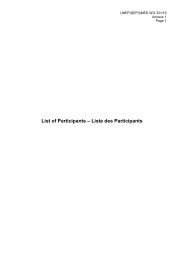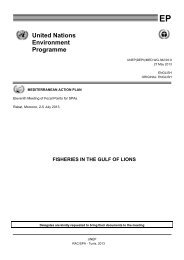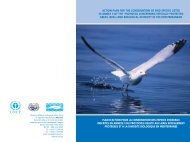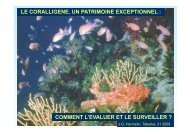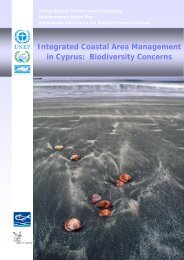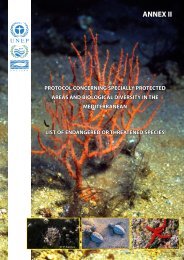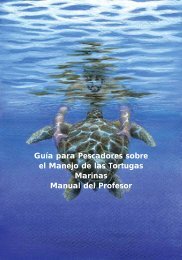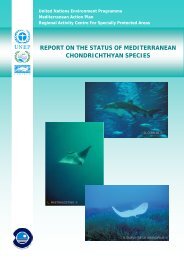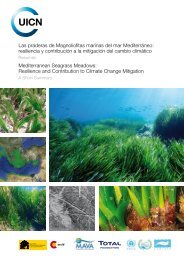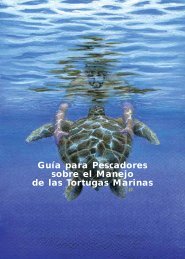Proceedings of the Second Mediterranean Symposium on Marine
Proceedings of the Second Mediterranean Symposium on Marine
Proceedings of the Second Mediterranean Symposium on Marine
You also want an ePaper? Increase the reach of your titles
YUMPU automatically turns print PDFs into web optimized ePapers that Google loves.
features <str<strong>on</strong>g>of</str<strong>on</strong>g> P. oceanica made it possible to definitely rule out <str<strong>on</strong>g>the</str<strong>on</strong>g> possibility that <str<strong>on</strong>g>the</str<strong>on</strong>g><br />
differences between most <str<strong>on</strong>g>of</str<strong>on</strong>g> <str<strong>on</strong>g>the</str<strong>on</strong>g>se maps may have been due to actual changes in <str<strong>on</strong>g>the</str<strong>on</strong>g><br />
seagrass meadow expanse. For example, <str<strong>on</strong>g>the</str<strong>on</strong>g> horiz<strong>on</strong>tal growth <str<strong>on</strong>g>of</str<strong>on</strong>g> a plagiotropic (=<br />
creeping) rhizome never exceeds 10 cm/a, and averages over l<strong>on</strong>g periods 4 cm/a<br />
(Boudouresque et al., 1984; Meinesz and Lefèvre, 1984). Therefore a progressi<strong>on</strong> <str<strong>on</strong>g>of</str<strong>on</strong>g><br />
more than 1 km in an <str<strong>on</strong>g>of</str<strong>on</strong>g>fshore directi<strong>on</strong> (between Mari<strong>on</strong>'s 1883 and Pruvot's 1897<br />
map), <str<strong>on</strong>g>the</str<strong>on</strong>g>n <str<strong>on</strong>g>of</str<strong>on</strong>g> nearly 1 km in <str<strong>on</strong>g>the</str<strong>on</strong>g> directi<strong>on</strong> <str<strong>on</strong>g>of</str<strong>on</strong>g> <str<strong>on</strong>g>the</str<strong>on</strong>g> shore (between <str<strong>on</strong>g>the</str<strong>on</strong>g> Pruvot and Picard<br />
1958 maps) is hardly credible (Fig. 1). Even <str<strong>on</strong>g>the</str<strong>on</strong>g> 1979 Cristiani map is dubious in some<br />
places (e.g. in <str<strong>on</strong>g>the</str<strong>on</strong>g> north-east part <str<strong>on</strong>g>of</str<strong>on</strong>g> <str<strong>on</strong>g>the</str<strong>on</strong>g> cove).<br />
In order to assess <str<strong>on</strong>g>the</str<strong>on</strong>g> value <str<strong>on</strong>g>of</str<strong>on</strong>g> <str<strong>on</strong>g>the</str<strong>on</strong>g> ancient maps, attempts have been made to estimate<br />
<str<strong>on</strong>g>the</str<strong>on</strong>g> reliability <str<strong>on</strong>g>of</str<strong>on</strong>g> maps (Iehlé et al., 1995; Pasqualini, 1997; Pergent-Martini, 2000;<br />
Leriche-Guichard, 2001; B<strong>on</strong>-homme et al., 2003). Leriche et al. (2004) have proposed<br />
a Reliability Index (RI), rated 1 to 50, which weights three parameters, within 3 depth<br />
ranges (0-5, 5-15 and >15 m): (i) <str<strong>on</strong>g>the</str<strong>on</strong>g> initial scale <str<strong>on</strong>g>of</str<strong>on</strong>g> <str<strong>on</strong>g>the</str<strong>on</strong>g> map (source map) and <str<strong>on</strong>g>the</str<strong>on</strong>g><br />
working scale (target scale); (ii) <str<strong>on</strong>g>the</str<strong>on</strong>g> method(s) <str<strong>on</strong>g>of</str<strong>on</strong>g> data acquisiti<strong>on</strong> (e.g. dredging, grabs,<br />
aerial photographs, side scan s<strong>on</strong>ar, scuba diving); and (iii) <str<strong>on</strong>g>the</str<strong>on</strong>g> method <str<strong>on</strong>g>of</str<strong>on</strong>g> geographical<br />
positi<strong>on</strong>ing <str<strong>on</strong>g>of</str<strong>on</strong>g> <str<strong>on</strong>g>the</str<strong>on</strong>g> data.<br />
Leriche et al., (2004) stated that <str<strong>on</strong>g>the</str<strong>on</strong>g> RI value <str<strong>on</strong>g>of</str<strong>on</strong>g>



